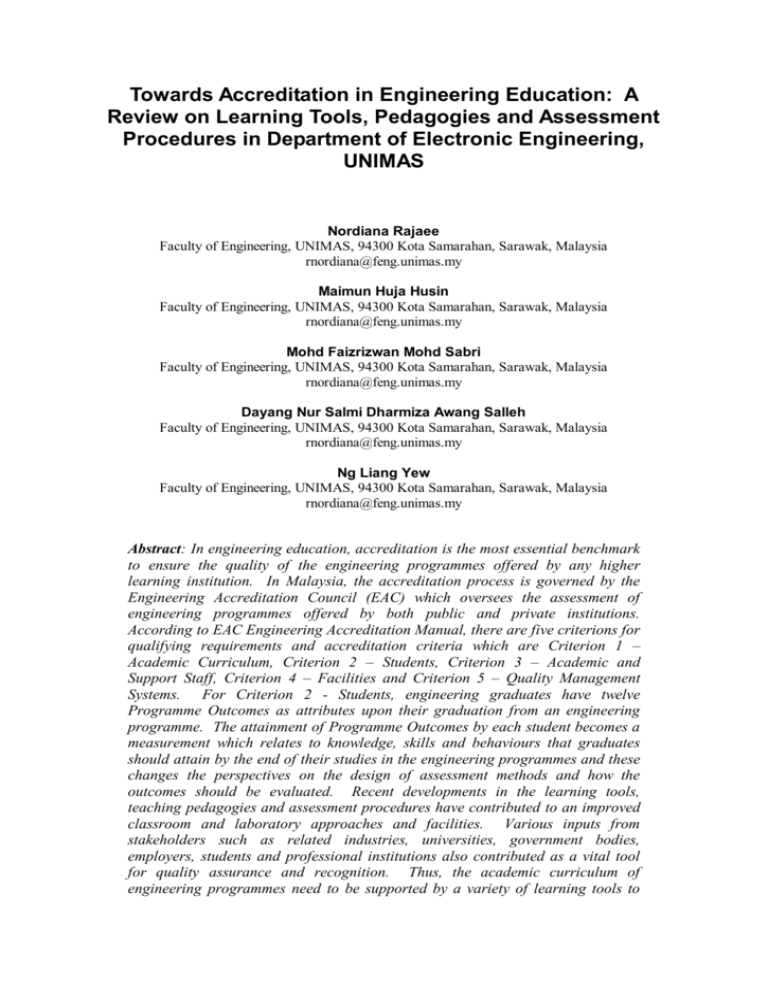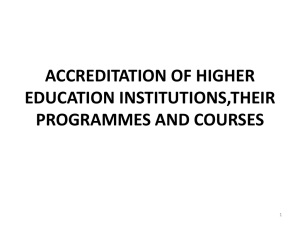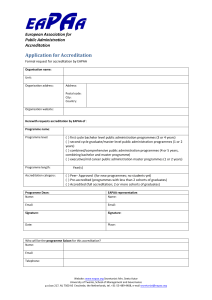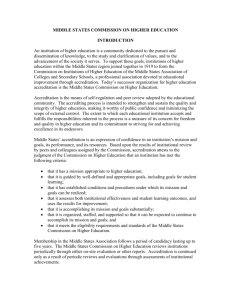Towards Accreditation in Engineering Education
advertisement

Towards Accreditation in Engineering Education: A Review on Learning Tools, Pedagogies and Assessment Procedures in Department of Electronic Engineering, UNIMAS Nordiana Rajaee Faculty of Engineering, UNIMAS, 94300 Kota Samarahan, Sarawak, Malaysia rnordiana@feng.unimas.my Maimun Huja Husin Faculty of Engineering, UNIMAS, 94300 Kota Samarahan, Sarawak, Malaysia rnordiana@feng.unimas.my Mohd Faizrizwan Mohd Sabri Faculty of Engineering, UNIMAS, 94300 Kota Samarahan, Sarawak, Malaysia rnordiana@feng.unimas.my Dayang Nur Salmi Dharmiza Awang Salleh Faculty of Engineering, UNIMAS, 94300 Kota Samarahan, Sarawak, Malaysia rnordiana@feng.unimas.my Ng Liang Yew Faculty of Engineering, UNIMAS, 94300 Kota Samarahan, Sarawak, Malaysia rnordiana@feng.unimas.my Abstract: In engineering education, accreditation is the most essential benchmark to ensure the quality of the engineering programmes offered by any higher learning institution. In Malaysia, the accreditation process is governed by the Engineering Accreditation Council (EAC) which oversees the assessment of engineering programmes offered by both public and private institutions. According to EAC Engineering Accreditation Manual, there are five criterions for qualifying requirements and accreditation criteria which are Criterion 1 – Academic Curriculum, Criterion 2 – Students, Criterion 3 – Academic and Support Staff, Criterion 4 – Facilities and Criterion 5 – Quality Management Systems. For Criterion 2 - Students, engineering graduates have twelve Programme Outcomes as attributes upon their graduation from an engineering programme. The attainment of Programme Outcomes by each student becomes a measurement which relates to knowledge, skills and behaviours that graduates should attain by the end of their studies in the engineering programmes and these changes the perspectives on the design of assessment methods and how the outcomes should be evaluated. Recent developments in the learning tools, teaching pedagogies and assessment procedures have contributed to an improved classroom and laboratory approaches and facilities. Various inputs from stakeholders such as related industries, universities, government bodies, employers, students and professional institutions also contributed as a vital tool for quality assurance and recognition. Thus, the academic curriculum of engineering programmes need to be supported by a variety of learning tools to improve the teaching and learning process such as hands-on laboratory works, simulation laboratories, problem based learning (PBL), case studies, integrated design project (IDP) and etc. This paper discusses the learning tools, pedagogies and assessment procedures utilized in the Department of Electronic Engineering UNIMAS in order to achieve the twelve Programme Outcomes to fulfill the requirement of EAC. Keywords: higher education, engineering education, learning tools Accreditation in Engineering Education The definition of accreditation in engineering education is most commonly adopted from the European standing Observatory for the Engineering Profession and Education (ESOEPE): “Accreditation is the primary quality assurance process to ensure the suitability of an educational programme as the entry route to the engineering profession. Accreditation involves a periodic audit against published standards of the engineering education provided by a particular course of program. It is essentially a peer review process, undertaken by appropriately trained and independent panels comprising both engineering teachers and engineers from industry. The process normally involves both scrutiny of data and a structured visit to the education institution (ESOEPE 2005)” In engineering education, accreditation is the most essential benchmark to ensure the quality of the engineering programmes offered by any higher learning institution. In Malaysia, the accreditation process is governed by the Engineering Accreditation Council (EAC) which oversees the assessment of engineering programmes offered by both public and private institutions. However, due to the increasing trend of globalization, there emerges a need to have an internationally recognized benchmark for engineering education which recognizes academic programmes across the nations based on a mutually agreed standard qualifications and criteria. This gave birth to Engineering Criteria 2000 (EC2000) by the Accreditation Board for Engineering and Technology (ABET) in United States. EC2000 was a revolutionary approach to accreditation criteria for engineering programmes as it is focused on the outcomes (learned) rather than input (taught) whereby specific mission and goals became indicators for measurement. The EC2000 also caused the shift in teaching and learning in engineering education pedagogies as well as the design of engineering educational programmes. With EC2000, new assessment processes for programme improvement allow flexibility and innovation in the programme development. Mutual recognitions of engineering in tertiary educational programmes are covered in three agreements: The Washington Accord 1989, The Sydney Accord 2001 and The Dublin Accord 2002. Signatories in The Washington Accord in 2013 are the United States, United Kingdom, Australia, New Zealand, Ireland, Canada, Singapore, Russia, South Africa, Chinese Taipei, Hong Kong, Korea, Japan, Turkey and Malaysia. The EAC is a delegated body by the Board of Engineers Malaysia (BEM) to accredit engineering programmes offered in the country. All graduate engineers must register with BEM to practice engineering in Malaysia to provide assurance that the engineering graduates have the necessary skills to perform as qualified engineers. According to EAC Engineering Accreditation Manual, there are five criterions for qualifying requirements and accreditation criteria which are Criterion 1 – Academic Curriculum, Criterion 2 – Students, Criterion 3 – Academic and Support Staff, Criterion 4 – Facilities and Criterion 5 – Quality Management Systems. For Criterion 2 - Students, engineering graduates should have the following Programme Outcomes as attributes upon their graduation from an engineering programme: a) b) c) d) e) f) g) h) i) j) k) l) Ability to apply knowledge of mathematics, science, engineering fundamentals and an engineering specialization to the solution of complex engineering problems; Ability to identify, formulate, research literature and analyse complex engineering problems reaching substantiated conclusions using first principles of mathematics, natural sciences and engineering sciences; Ability to design solutions for complex engineering problems and design systems, components or processes that meet specified needs with appropriate consideration for public health and safety, cultural, societal, and environmental considerations; Ability to conduct investigation into complex problems using research based knowledge and research methods including design of experiments, analysis and interpretation of data, and synthesis of information to provide valid conclusions; Ability to create, select and apply appropriate techniques, resources and modern engineering and IT tools, including prediction and modeling, to complex engineering activities, with an understanding of the limitations; Ability to apply reasoning informed by contextual knowledge to assess societal, health, safety, legal and cultural issues and the consequent responsibilities relevant to professional engineering practice; Ability to understand the impact of professional engineering solutions in societal and environmental contexts and demonstrate knowledge of and need for sustainable development; Ability to apply ethical principles and commit to professional ethics and responsibilities and norms of engineering practice Ability to communicate effectively on complex engineering activities with the engineering community and with society at large, such as being able to comprehend and write effective reports and design documentation, make effective presentations, and give and receive clear instructions; Ability to function effectively as an individual, and as a member or leader in diverse teams and in multi disciplinary settings; Ability to recognize the need for, and have the preparations and ability to engage in independent and lifelong learning in the broadest context of technological change; Ability to demonstrate knowledge and understanding of engineering and management principles and apply these to one’s own work, as a member and leader in a team, to manage projects and in multidisciplinary environments; The attainment of Programme Outcomes by each student becomes a measurement which relates to knowledge, skills and behaviours that graduates should attain by the end of their studies in the engineering programmes and these changes the perspectives on the design of assessment methods and how the outcomes should be evaluated. Recent developments in the learning tools, teaching pedagogies and assessment procedures have contributed to an improved classroom and laboratory approaches and facilities. Various inputs from stakeholders such as related industries, universities, government bodies, employers, students and professional institutions also contributed as a vital tool for quality assurance and recognition. The whole assessment process is a continuous with opportunities forimprovement loop which requires additional workload from the engineering institutions. The broad expectation on the characteristics or attributes expected to be attained by engineering graduates upon completion of a programme such as communication skills, problem solving, ethics, leaderships skills, social awareness, decision making and ability to work in multidisciplinary teams put pressure on engineering programmes to produce graduates meeting the demands of the stakeholders. According to Dudman and Wearne (2003), the engineering career is not solely focused on technological expertise but also covers a variety of managerial skills such as leadership skills, teamwork and project management. The ability to work within multicultural and multinational workplace environments is also key issues for global mobility of an engineer. Baillie and Fitzgerald (2000) state that employers need employees with good critical, analysis and communication skills to relate innovative solutions within team based environment. For the graduates of Electronics (Telecommunication) Engineering Programme (PKET) in Department of Electronics Engineering UNIMAS, the attainment of the Programme Outcomes is mapped to the courses offered in the programme as in Table 1. Table 1: PKET Courses vs Programme Outcomes a b Circuit Theory X X Electrical Engineering Technology X X COURSES \ PROGRAMME OUTCOMES Measurement and Instrumentation c d X Structured Programming X Engineering Mathematics I X X Analog Electronics X X Digital Electronics X X Analog and Digital Electronic Applications Engineering Design Foundation X Electrical Instrumentation X X Engineering Mathematics II X X Digital System Application Telecommunication Engineering Principles X X X X Engineering Mathematics III X X Electronic Circuits X X X Numerical Methods and Statistics X X i X X j X X X X X k X X X X X X Digital Signal Processing X X Control System Engineering X X Microprocessor X X X X X X X X l X X X X h X Analog and Digital Communication Applications Computer System Operations g X X X Signal & Systems f X X Software Engineering Advance Electronic System Application e Engineering Ethics X Microelectronics Electromagnetic Theory X X X X X Data and Computer Networking Optoelectronics X X X X X Industrial Training VLSI Design X Microwave and Antenna Technology X Optical Fiber Communication X X X X Telecommunication Networks and Services X X X X X X X X X X X X X X X Final Year Project I X X X Integrated Design Project I X X Mobile and Wireless Communication X X Final Year Project II X X Integrated Design Project II X Engineering Management X X X X X X X X X X X X X X X X X X X X X X X Learning Tools and Pedagogies for Achievement of Programme Outcomes The widespread technology of internet has revolutionized the way information is retrieved by the students. The immediate availability of information is changing the way students learn. Thus, the traditional talk-and-chalk lectures are insufficient to face the requirements from the stakeholders to develop their graduates with wider skills base. The academic curriculum of engineering programmes need to be supported by a variety of learning tools to improve the teaching and learning process such as hands-on laboratory works, simulation laboratories, problem based learning (PBL), case studies, integrated design project (IDP) and etc. Faced with the external inputs and demands of the stakeholders, these factored in the change of complex evaluative tools to measure the Programme Outcomes of the engineering programmes. ABET recommended more use of open-ended questions and formulation of design problems for the development of more innovative engineers. In the Department of Electronics Engineering UNIMAS, teaching and learning consists of the following approaches: Lectures Traditional lecture or teaching approaches is conducted for 30 courses out of 40 courses in the engineering programme. The number of hours for the lectures is based on the credit hour which complies with the EAC standard which is one credit hour for each hour of lecture. Most lecture-based courses are theoretical courses where basic knowledge in mathematics, science and engineering fundamentals is covered. While the lecture notes and assignments are mostly uploaded in the UNIMAS Teaching and Learning Online System (Morpheus), traditional lectures are still most commonly practiced in the engineering programmes compared to other disciplines. Most of the courses cover PO (a) and PO (b) of the EAC Programme Outcomes and the remaining courses which are not conducted in lectures are the physical laboratory courses, PBL, IDP and final year projects (FYP). Laboratory Works The integration of laboratory works differentiates the engineering programme from many other disciplines and is an essential tool to enhance understanding of theories in engineering and technology education. There are two types of instructional laboratories (i) physical laboratory (ii) simulation laboratory. The physical laboratories are usually conducted in the same semester as the courses covering the theoretical aspects of the courses while the simulation laboratories may be independent of any other prerequisites or embedded in the lecture-based courses themselves. Physical laboratories have been in practice for tertiary engineering education for many years and comprise of hands-on experiments. These are covered in Measurement and Instrumentation, Analog and Digital Electronic Application, Digital System Application, Analog and Digital Communication Application and Advance Electronic System Application. These physical laboratory courses mainly cover PO (b), PO (e) and PO (i) whereby Written Reports are primary form of assessment. The simulation laboratories are embedded in the lecture-based courses such as Structured Programming, Engineering Design Foundation and Software Engineering, Electronic Circuits, Digital Signal Processing and VLSI Design. In the simulation laboratories, the students are introduced to the basics and applications of Matlab, PSpice, C++, Electronic Workbench, Multism and etc. Case Studies The insufficiencies of traditional pedagogy to develop the skills of the engineering graduates led to the introduction of new didactic approaches such as case studies, PBL, PoPBL and IDP. Case study is a qualitative research method which excels at bringing us to an understanding of a complex issue while examining contemporary real-life situations. With the existing gaps of intended graduate attributes and actual performance in workplace, case studies give the option to simulate the problem and provide the basis for application of ideas. While critics dismiss case studies as no other than an exploratory tool, case studies have been widely applied in teaching and learning for the assessment of “soft” skills rather than “hard” technical skills. The development of analytical, evaluative and decision making skills are of extreme importance in engineering and managerial positions. The practice will also improve communication skills as case studies also emphasize on working towards a consensus while tolerating legitimate differences of opinions. In PKET, case studies are used in Engineering Ethics covering PO (f) and PO (h); and Engineering Management covering PO (i), PO (i) and PO (l). Problem Based Learning Schon (1987) suggested that engineers reflect in action and these skills cannot be taught in classroom or laboratory. Therefore much interest has been shown in the use of PBL as alternative methods of teaching (Boud 1985, Savin Baden 2000, Kolmos et al 2007). In PBL, students take charge of what needs to be learned and how it should be learned, providing a platform for them to develop teamwork, problem solving and leadership skills. A well designed PBL course also introduces students to lifelong learning and thus satisfies many outcomes specified by EAC. PBL is offered in Data Computer and Networking course where the students are divided into groups of five and the lecturer becomes the facilitator. For the PBL course, the students are expected to provide solution to the problem within a semester and the assessment of the course incorporates both the student assessment and the continuous assessment of the course itself using Log Book, Software Development, Hardware Development, Written Report, Oral Presentation, and Peer Evaluation covering PO (c), PO (i), PO (j) and PO (k). Integrated Design Project Integrated design project (IDP) is a project which spans over two semesters that builds upon knowledge from previous multidisciplinary courses. IDP courses are the most recent requirement from EAC to be integrated into the curricula in order to prepare the students for the transition into engineers. These integrated design projects also incorporates inputs from the external stakeholders such as local governments and industries and designed to bring all aspects of an undergraduate learning experience into practice. Effective IDP is of high interest to the external stakeholders as the goal is to equip graduates with various engineering skills. The IDP is intended to develop the technical, planning, project management, leadership and teamwork, analysis and evaluative skills of the students. The integration of IDP in the curricula is essential as IDP highly promote “soft” skills such as ethics and communication skills with diverse others throughout the completion of the IDP. Integrated Design Project I and Integrated Design Project II cover a total of ten Programme Outcomes from PO (c) to PO (l). Final Year Project Final Year Project (FYP) is an individual project undertaken by the students which also spans over two semesters. Guided by a supervisor, the FYP topic which was distributed at the beginning of their Fourth Year must be completed inclusive of software / hardware. The assessment of FYP will be divided into three categories, the written report (FYP Thesis), Software/Hardware and Oral Presentation. The FYP is significant project for any undergraduate engineering student as it showcases the practical application of knowledge, organizational and management skills of the student. FYP I and FYP II cover PO (c), PO (d), PO (e), PO (h), PO (i) and PO (j). Industrial Training Industrial Training refers to students’ attachment to an industry as part of their exposure and experience in real life working environment. For PKET students, the Industrial Training is compulsory and the students must complete ten weeks training in a related engineering industry. The assessment of the Industrial Training will be based on the Log Book, Employer’s Assessment, Visiting Lecturer’s Assessment, Written Report and Oral Presentation. When undergoing Industrial Training, the student will be fully liable to the organization and the student’s overall performance will be assessed by the organization. Industrial Training covers PO (f) to PO (k). Assessment for Accreditation "Assessment is the systematic collection, review, and use of information about educational programs undertaken for the purpose of improving student learning and development." (Palomba & Banta, 1999). The core objectives of assessment in higher learning are to improve student learning and to gain better insight to how students learn. To prepare the students with a set of definite skills, knowledge and attitudes, the assessment must provide an opportunity for the students to participate in the construction of their knowledge and the gathered information must also include the viewpoint of our educational programmes from the learners. An effective assessment is a comprehensive, systematic and continuous process for the improvement of the quality of education. The cyclical nature of learning assessment should be based on multiple sources that are meaningful to the programme. Feedbacks from students and external stakeholders are crucial to improve the teaching, learning and assessment methods in the programme and for that matter, the programme outcomes must first be clearly defined. It is necessary to ensure that all Programme Outcomes are attained by the students upon completion of the programme and the documentation process (evidence gathering) must be comprehensive for the purpose of accreditation. Course File The first and foremost importance in the evidence gathering is the construction of Course Files. All courses are required to keep a Course File containing teaching and learning materials for the course such as lecture notes, quizzes, assignments, projects, tests, final exam questions, attendance list and student grades. Samples of best, moderate and weak students’ answer sheets for each assessment are also included in the Course File for reference. End Semester Report The attainment of all Programme Outcomes by the students is related to how well the programme prepares the students for their career in the engineering field. For PKET, the performance of each student is monitored using End-Semester-Report (ESR) which measures the attainment of the learning outcomes (LO) in a course. By aligning each learning outcomes with a Programme Outcome, each PO assessment can be analyzed and interpreted in detail. The evidence gathered also measures the strength and efficiency of an approach or assessment method in teaching and learning. An example of the relationship between learning outcomes vs Programme Outcomes for Electronic Circuits course is given in Table 2. By the end of this course, the students should be able to: LO1 LO2 LO3 Analyze basic circuit configurations to construct low and high frequency responses by applying BJT and FET small signal analysis. Solve basic electronic circuits such as op-amps, power amplifiers, linear digital ICs, feedbacks, oscillators and voltage regulators Utilize appropriate modern tools to design and generate electronic circuits (e.g. Pspice, Electronic Workbench, Multism etc) PO Assessed PO (b) PO (a) PO (e) Table 2: Relationship between learning outcomes and Programme Outcomes for Electronic Circuits course For Electronic Circuits course, the distribution of marks is given as Assignment (10%) which assesses PO (b), Project (10%) assesses PO (e), Quiz 1 (5%) assesses PO (b), Quiz 2 (5%) assesses PO (a), Test 1 (10%) assesses PO (b), Test 2 (10%) assesses PO (a), Final Exam (25%) assesses PO (b) and Final Exam (25%) assesses PO (a); for a total of 50% assessment for PO (b), 40% assessment for PO (a) and 10% assessment for PO (e). In the ESR, the achievement of individual assessment for each student is analyzed and accumulated to give an overall PO achievement statistics as shown in Figure 1. The overall PO achievement indicates the percentage of students achieving the PO (a) as 67%, PO (b) as 55% and PO (e) as 100%, out of a total of 82 students. The achievement of certain Programme Outcomes can be improved via analysis of marks distribution breakdown in Figure 2. A Continuous Quality Improvement (CQI) report must be submitted by the lecturer after each ESR analysis for comments and recommendations for improving the course. Course Evaluation Survey and Students’ Survey are also conducted at the end of the semester to assess students’ perception of their own understanding in the given course and general feedback on how to improve the delivery of the course. Overall PO Achievement 120 Percentage of Achievement 100 100 80 67 60 55 40 20 0 (a) (b) (c) (d) (e) (f) (g) (h) (i) (k) (l) Programme Outcomes Figure 1: Overall PO Achievement for Electronic Circuits course Final Exam Full Marks Strongly Achieved Test Others Q1 Q2 Q3 Q4 T1 T2 Proj Assignmen t Quiz 1 Quiz 2 12.5 % 12.5 % 12.5 % 12.5 % 10% 10% 10% 10% 5% 5% 14 10 8 16 12 26 82 78 71 80 19 16 27 25 26 30 0 0 10 2 24 24 30 31 32 22 0 4 0 0 25 32 17 10 12 4 0 0 1 0 (75% - 100%) Achieved (50% - 74%) Not Achieved (25% - 49%) Strongly Not Achieved (0% - 24%) Figure 2: Breakdown analysis of Marks Distribution (No. of Students) However, not all programme outcomes can be objectively measured. As opposed to “hard” technical skills, “soft” skills such as ethics, social responsibility, professionalism, communication, teamwork, management and lifelong learning are difficult to be measured using traditional exam-based assessment methods. Thus, reflective essays, written reports, oral presentations and peer evaluations are also utilized to assess the outcomes. The new requirement from EAC regarding fifty percent failures in Final Exam is equivalent to failure in the course has also put pressure on the academic programmes to implement moderation on the continuous assessments. Higher level of Bloom Taxonomy is expected for all continuous assessments in the cognitive, psychomotor and affective domains to encourage critical thinking, decision making skills, cultivate cooperation in intercultural settings and awareness of social and global responsibility in the engineering profession. The use of reflective essays is applied in the assessment of PO (f), PO (g) and PO (h). In Telecommunication Engineering Principles, Telecommunication Networks and Services, and Mobile and Wireless Communication, reflective reports on site visits or seminars from invited industrial speakers relate the students to engineering and its impact on the society. Oral Presentation is utilized to inculcate students’ ability to communicate effectively in verbal communication and relate information in a concise and organized manner. Oral Presentations can be both carried out individually or in a team based on the projects or assignments given in Data and Computer Networking, Optoelectronics, Microwave and Antenna Technology, Industrial Training, Integrated Design Projects and Final Year Projects. Lifelong learning elements in PO (k) are assessed using both reflective essays and design works by taking into consideration of future trends in courses such as Computer System Operations, Digital Signal Processing, Data and Computer Networking, VLSI Design and Integrated Design Projects. Teamwork and leadership skills in PO (j) and PO (l) are assessed using group projects in Analog and Digital Electronic Applications, Microwave and Antenna Technology, Integrated Design Project and Engineering Management courses. To instill a broader base of related interpersonal communication, project management and entrepreneurship competencies, undergraduates also have to register for University courses, Generic courses and Complementary courses offered during their four year study in PKET. The inclusion of third languages such as Arabic, Japanese, French, German, Spanish and Mandarin offered by Center for Language Studies, English for Professional Purposes, Academic Reading and Writing, English in the Media, English for Self Expression, Preparatory English, Bahasa Melayu also aims to improve students’ oral and written communication skills for PO (i). PO (e) is also covered in strengthening courses such as End-User Computing and IT Tools for Knowledge Workers. Other courses such as Islam and South East Asian Civilization, and Ethnic Relations include PO (f) and PO (k) themes in their assignments while Basic Entrepreneurial Culture course helps students to cultivate entrepreneurship and project management skills for PO (l). PALAPES (Army Training) and SUKSIS (Police Training) courses are additional elective courses for the students. Conclusion The requirement of engineering graduates to fulfill EC2000 has become a basis as one of the criteria for accreditation of an engineering programme. The need for an engineer to not only acquire substance related technical skills but also the necessary behaviours, awareness and competencies has led to the advancement of more complex teaching, learning and assessment tools to evaluate the quality of engineers produced by an engineering programme. Solving a technical problem is not a goal but more so a means for experiential and student-centered learning. Designs of course materials are also instrumental in developing thinking, emotion and social skills to prepare the graduates for success in organizations and their professional careers. References Baillie C., Fitzgerald G., (2006), Motivation and attrition in engineering students, European Journal of Engineering Education, vol. 25, no. 2, 145-155 Dudman A., Wearne S.H., (2003) Professional engineers’ needs for managerial skills and expertise, Centre for Research in the Management of Projects, University of Manchester Institute of Science and Technology. Innovation Insights Series Number 11, (2005), Assessing for Improvement, The Pennsylvania State University. Macho-Stadler E., Elejalde-Garcia M.J., (2013), Case study of problem based learning course of physics in a telecommunications engineering degree, European Journal of Engineering Education, vol. 38, no.4, 408416. Palomba C.A., Banta T.W., (1999), Assessment essentials: planning, implementing and improving assessment in higher education, Jossey Bass Publishers, San Francisco Patil A. & Codner G., (2007), Accreditation of engineering education: review, observations and proposal for global accreditation, European Journal of Engineering Education, vol. 32, no. 6, 639-651. Patil, Nair & Codner, (2008), Global Accreditation for the Global Engineering Attributes: A Way Forward, Proceedings of the 2008 AaeE Conference, Yeppoon. Savin-Baden M., (2000), Problem based learning in higher education: untold stories, The Society for Research into Higher Education, Open University Press Schon D., (1987), “Educating the Reflective Practitioner”, The Meeting of American Educational Research Association, Washington DC Zandvoort H., Van Hasselt G.J., Bonnet A.B.A.F, (2008), A joint venture model for teaching required courses in ‘ethics and engineering’ to engineering students, European Journal of Engineering Education, vol. 32, no.2, 187-195 Zaugg H. & Randall S. D., Communication skills to develop trusting relationship on global virtual engineering capstone teams, European Journal of Engineering, vol. 38, no. 2, 228 – 233. Copyright statement nd Copyright © 2013, N Rajaee, M. H. Husin, M. F. M. Sabri, D. N. S .D. A. Salleh, L. Y. Ng: The author/s assign to 2 International Higher Education Teaching and Learning Conference 2013 a non-exclusive licence to use this document for personal use and in courses of instruction provided that the article is used in full and this copyright statement is reproduced. The author also grants a non-exclusive license to the organisers of the 2nd International Higher Education Teaching and Learning Conference 2013 to publish this document as part of the conference proceedings. Any other usage is prohibited without the express permission of the authors.







